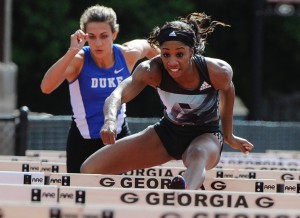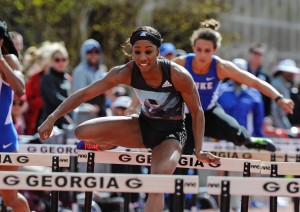12.36? OMG!
In the further adventures of Kendra Harrison, she ran a legal (+1.4) 12.36 last weekend at the Spec Towns Invitational in Georgia – a low key meet with relatively little competition. Her time stands as the fastest season opener in history, and ranks her among the top five of all time in American history.
Because I coached Keni in high school, a lot of people pick my brain in regards to her success. I try not to talk about her too much, since our years together are a good five years removed and I am not in on her daily training routine. But when it comes to The Hurdle Magazine, I feel a responsibility to share with my subscribers my insights on her development and the specifically hurdle-related reasons for her success.
[am4show not_have=’g5;’]
[/am4show][am4guest]
[/am4guest][am4show have=’g5;’]
In a recent article I predicted that she would break 12.40 this year, but I didn’t think she’d do it so soon. Coming off a strong indoor season and an outdoor personal best of 12.50 from last year, I felt like she could pick up where she left off, but she has already exceeded my expectations.
So, the question is, what is Keni doing to run so fast?
Answering that question could very well lead into a treatise on the keys to success in the women’s 100 meter hurdles. With that thought in mind, let us proceed.
There are three big keys to Keni’s success and improvement: 1) her speed between the hurdles, 2) low hurdle clearance, 3) a lightning quick lead leg.
Of the three, Keni’s hurdle clearance is what has improved the most since last year, and it is what best explains her drop from 12.50 to 12.36. In texting with her after her race last week, she mentioned that her hurdle clearance, especially in the second half of the race, was much lower than it had been previously. In the second half of races last year, she was higher over the hurdles, floated a bit, and was a little sloppy. I agree with her that her improved low hurdle clearance is noticeable and significant.

In this photo from last week’s race, you can see how low she clears the hurdle, but you can also see that the knee of the trail leg is slightly lower than where it needs to be at this point of hurdle clearance. The knee is still slightly below the bar, which means she will need to raise it while bringing it forward, as opposed to being able to just bring it forward.

In this photo, also from her 12.36 race, you can see that she continues to skim the hurdle as she descends. The trail leg here is a bit wider than optimal. The knee at this point should be a little higher, moving up into her chest.
Keni’s speed between the hurdles has always been one of her strengths, and she has gotten faster with each succeeding year. She’s put on a lot of muscle since the days when I coached her, and her body has adjusted well to the increased strength. I think her increased speed may have contributed to her crashing into hurdle one at the recent indoor world championships.
In regards to her lead leg, one of the things that has slightly annoyed me actually, over the course of her collegiate and now professional career is that she has become what I refer to as a lead-leg-dependent hurdler, meaning she rides her lead leg all the way down the track. Obviously, this is not necessarily a bad thing, but to me, it is a limiting thing. The good aspect lies in the fact that her hurdle clearance time is insane. Her lead leg / lead arm action is so fast that these two limbs propel her down the track.
I’ll talk about Keni’s trail leg in just a bit, but first let me directly discuss the conclusions that can be drawn from her success as it pertains to the women’s race as a whole. The obvious conclusion is that speed between, low clearance, and a fast trail leg are the three elements of hurdling that coaches of female hurdlers should focus on when coaching women hurdlers. Then when you look at other top women hurdlers like Rollins, Stowers, Nelson, Quern Harrison, Ali, and several others, it would seem evident that these three elements are keys to success. Looking at back-in-the-day hurdlers like Gail Devers, Joanna Hayes, and Michelle Perry further supports the claim.
As for the trail leg, Keni’s is still a work in progress, and it’s a topic that comes up every time we talk. Even after her 12.36, she commented that she hit a couple hurdles late with her trail leg, and that she was moving so fast that she “was just trying to survive.”
In many of her races last year, she had control issues on the trail leg side of her body late in races, leading to excessive deceleration. To put it simply, her lead leg is moving so fast that her trail leg can’t keep up.
I told her that if she can get her trail leg to keep up, she can legit run sub 12.30 on a consistent basis. I feel that a heavy emphasis on one-step drills, with variations in spacing, can serve as the method to teach her trail leg to adapt to her speed.
While it would be easy to say, hey, she ran 12.36 for her opener, so if it ain’t broke don’t fix it, Keni does want to fix her trail leg. Sally Pearson has shown us all the importance of being a complete hurdler, of not allowing any aspect of technique to be a weakness. No matter how fast you can run with a lazy trail leg, you can run even faster with a sharp one.
Unfortunately, the low height of the women’s hurdles has encouraged a lesser technical emphasis, as women can get away with flaws that men cannot. I wouldn’t be surprised if we see sub 12.40 become a new standard of excellence, a new normal, if you will. I wouldn’t be surprised if Keni will NEED to run sub 12.30 to win a gold medal, since there are so many speed demons amongst the women hurdlers these days. Because she opened the season with a blazing fast time, the other women will most likely follow suit. All of which means, if she doesn’t get her trail leg right, she may regret it.
Let me just add as a side note that Keni is unique in that a quiet fire burns within her. She hates to lose, and she’s never satisfied with yesterday’s performance. To quote a phrase from one of my favorite novellas, she has a “brute persistence” about her, a quiet but unyielding determination to excel and to master her event. This quality of her character goes far in explaining how she’s been able to become one of the best 100 meter hurdlers in the world.
The video above of Harrison’s 12.36 race is not the best, but it does allow you to see the things discussed in this article, although the flaws in the trail leg would be more evident from a head-on view.
[/am4show]
